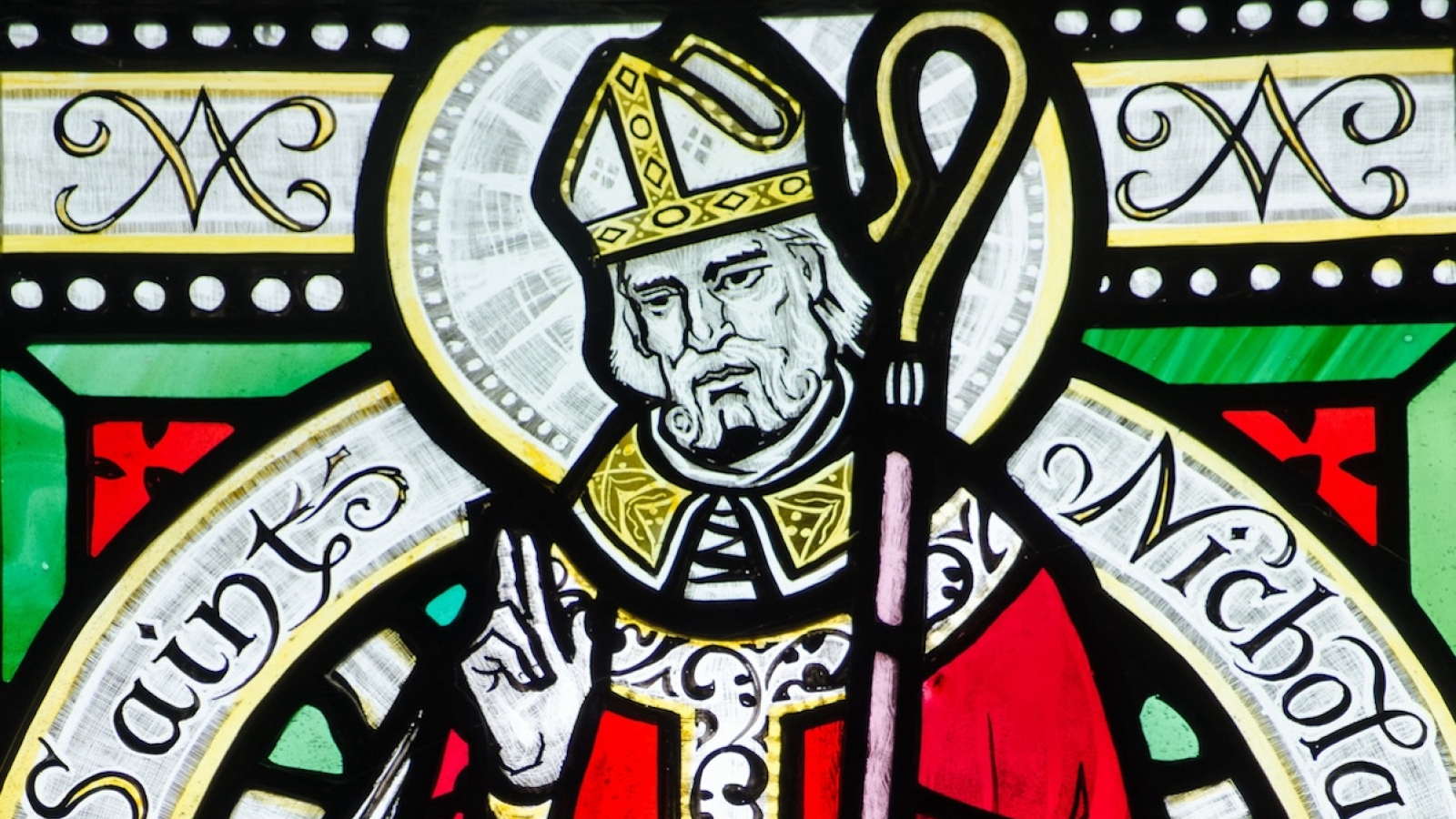A Soundtrack for a Saint
Beyond the cultural link to Santa Claus, Saint Nicholas has many connections to music, which Associate Professor of Music Mary Channen Caldwell is exploring for an upcoming book.

You probably know of Saint Nicholas through his association with Santa Claus, but that’s a relatively recent development in his 1,700-year history.
Associate Professor of Music Mary Channen Caldwell became interested in the saint when she realized how connected he is to music, through both the miracles attributed to him and the works written about him.
Caldwell is working on a book focused on music for and about Saint Nicholas in medieval popular devotional culture, and how this music shows different approaches to veneration through song. “Jolly Old Saint Nicholas,” it turns out, is just the tip of the iceberg.
Studying Saint Nick
Caldwell is a musicologist who works mainly on medieval Europe. “I focus on song, broadly understood—essentially works that combine melody and text,” she says. She was finding material related to Nicholas permeating the medieval archives with which she was working, in different repertoires and even across languages.
Historians aren’t certain, though they’re pretty sure, that Saint Nicholas was a real person. He lived in the third and fourth centuries and was Bishop of Myra, a Byzantine town in what is now Turkey. He first appears in Greek writings in the fifth and sixth centuries; Latin accounts then turned up in Western Europe in the eighth and ninth centuries, and his cult quickly grew. Nicholas became so well-known and well-loved that in 1087 Norman-Italian sailors traveled to Myra and brought the physical remains of his body, or relics, back to Europe. “He becomes this phenomenally popular saint,” Caldwell says. “New miracles were recorded about him across Europe.”
Nicholas is still one of the most recognizable Christian saints, despite the Catholic Church making his feast day optional in the 1960s. He is popular in various denominations in the Western church and also in the Eastern Orthodox Church. “Nicholas in the Middle Ages was kind of a saint for everyone, and I think he’s continued to hold that status,” says Caldwell.
She thinks his appeal was partly because he was a bishop, part of both religious and secular communities. Clerics admired him, and he is the patron saint of many different places, communities, and professions. “His miracles are wide-ranging, touching a wide assortment of people: young children, clerics, merchants, sailors, married women, pregnant women, scholars. The list goes on and on. He could fit a lot of needs,” she says. “He was someone who could become everything to everyone.” Caldwell believes music was a factor in his ever-expanding popularity.
Saintly Songs
During the Middle Ages, Nicholas acquired the usual accouterments of a saint: text, music, art, sculpture, and ritual. This included his liturgy, the chants sung on his feast day of December 6 (near enough to Christmas that, combined with his legendary habit of giving gifts, it led to his association with Santa Claus beginning in the 18th century).
“One of the primary ways saints were venerated in medieval Europe was through a liturgy for their feast day,” usually concerned with the miracles the saints enacted or their lives, says Caldwell. Nicholas’ liturgy was very popular, transmitted in many liturgical books.
Song is the medium by which most people encountered him, and it was the main way in which people could form an intimate connection with the saint.
Unusually, though, Nicholas was also a common subject in music outside church use. “There are songs across genres written for him, and they often also emphasize the role of song in celebrating him,” says Caldwell. “So, there’ll be a song that says, ‘Let’s sing a song about Saint Nicholas.’ It’s self-consciously all about singing and song.”
Songs about him were written by and for priests and monks, but also for lay communities and even children, telling stories of Nicholas’ miracles in simple, straightforward ways. Songs could also be a way to appeal to the saint for a miracle: young unmarried women asking to meet their soulmates, for example, or sailor shanties asking for safety.
The songs also crossed language barriers. Most were written in Latin by people living and working in religious institutions. “But they also, in their everyday lives, were speaking vernacular. So we get songs in the vernacular, or we get songs that are bilingual or multilingual,” says Caldwell. “It’s really interesting to think about how song intervenes in that dual character of language in the sense that they had two or more languages that they were trying to navigate between, with Latin having these strong connotations of seriousness and an academic religious overtone. But then the vernacular was what they were thinking in and talking in on a daily basis.”
Musical Miracles
Beyond the songs about Saint Nicholas, “miracles recorded about him also talk a lot about music,” Caldwell says. “That’s not typical for most saints. Not only that, but these miracles actually place music as central to his intercession in human affairs.”
One story involves the head of a small priory in medieval France who refused to let the monks sing Saint Nicholas’ liturgy. “When the prior goes to bed that night, Nicholas appears to him and proceeds to whip him while singing part of his own liturgy, teaching the prior how to sing it,” Caldwell says. “And he does this until the prior agrees to allow his brethren to actually sing the liturgy. This is a miracle that we find in dozens of manuscripts, so lots of people knew it. It’s all about the power and importance of music in Nicholas’ cult.”
Ultimately, says Caldwell, her book examines the intersection of music and hagiography, as well as how music and the idea of the saint in medieval Europe work together. The sources reveal how people in the 11th century onward were starting to “figure out how to think about song, how to write it down, how to structure it, where it fits into their lives,” Caldwell says.
“And then for Nicholas in particular, I’m showing that he was an intensely musical saint, that music was one of the primary means by which people explored his call, by which they venerated him. Song is the medium by which most people encountered him, and it was the main way in which people could form an intimate connection with the saint.”



